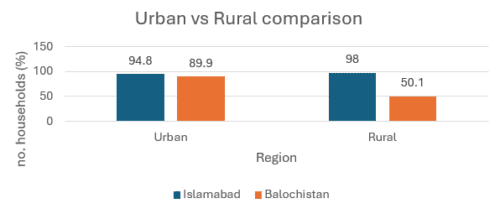
Visa Rejections to Germany Rise Post-Covid: India Recovers, Pakistan and Nepal Struggle
July 11, 2025
Exports, Imports and Imbalance: Pakistan’s 2024 Trade Deficit Tells a Familiar Story
July 11, 2025By Zehrish Iqbal
Intern – GDAP Summer Program 2025
The Aga Khan University
The Digital Census 2023 reveals that 84.6% of the households in Pakistan have access to electricity. This means that on the surface Pakistan appears to be progressing well, but a closer look reveals the disparities between provinces, especially between rural and urban areas.
In Islamabad 96.6% of households have electricity access. On the other hand, in Balochistan only 60.6% of the households have electricity access (lowest among provinces). This divide does not end here; it is visible within the province. The urban Balochistan, 89.9% of households have electricity, however, in rural Balochistan only 50.1% of households have electricity access. Compared this to Islamabad, where 98% of rural households and 94.8% urban households have electricity access. This reflects that the government has given development priorities to the capital, where the rural areas benefit from government investment and planned infrastructure.

In parts of Balochistan where the national grip has not reached yet, people are turning to solar power as an alternative. Three Tehsils; Sangan with 95.3%, Gharyum with 90.1%, and Sherani with 85.8% of the households have solar panels. These three Tehsils stand notable for high solar usage nationwide. These gaps can be due to several reasons like geography, conflict-prone regions etc. Balochistan, being a mountainous and desert region, makes it hard and expensive to give electricity access over such a long distance. Also, due to conflicts and safety concerns, many electricity development projects are delayed or cancelled. Meanwhile, Islamabad benefits from planned development, strong infrastructure, and high visibility. This difference shows how centrality, institutional presence, and political attention affect public service delivery.
This uneven development raises urgent questions about the state’s commitment to equitable service delivery and the rights of underserved communities. If Pakistan is to take its inclusive development seriously, it must go beyond token solar pilot projects and prioritize large-scale rural electrification, particularly in provinces like Balochistan.
For more information:
https://galluppakistandigitalanalytics.com/digital-population-and-housing-census-2023/
